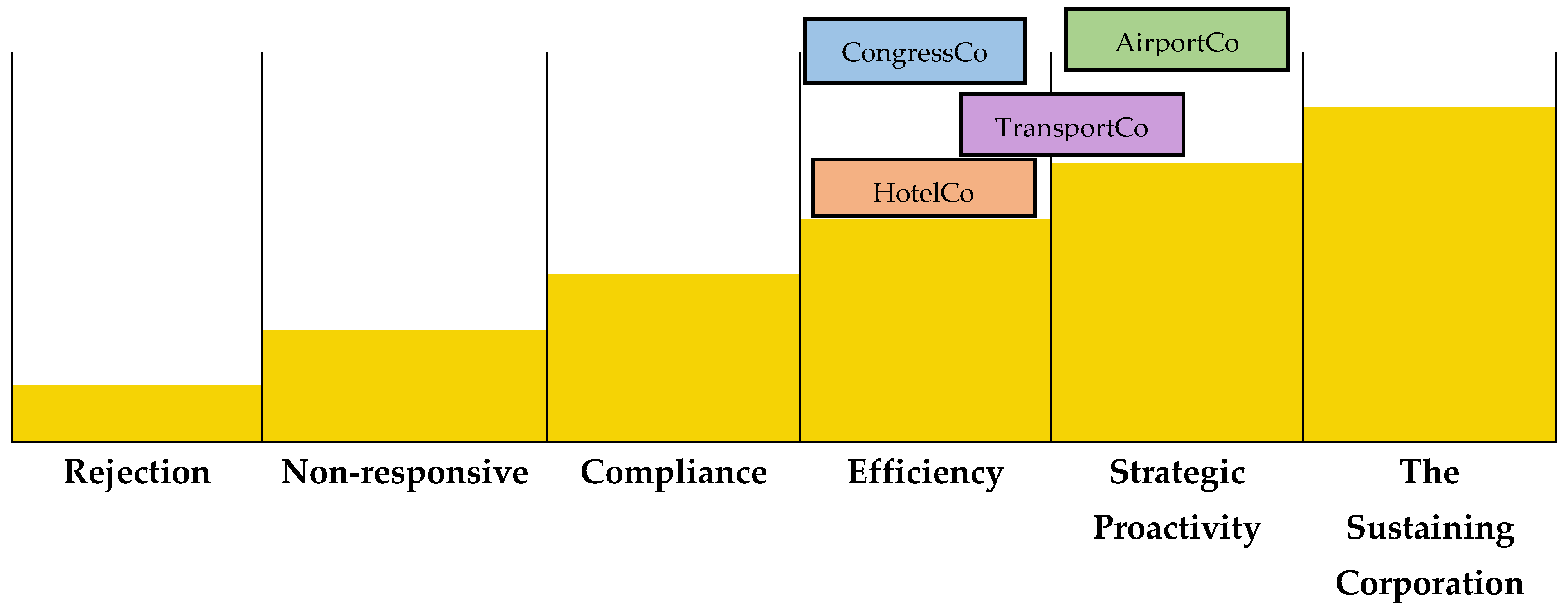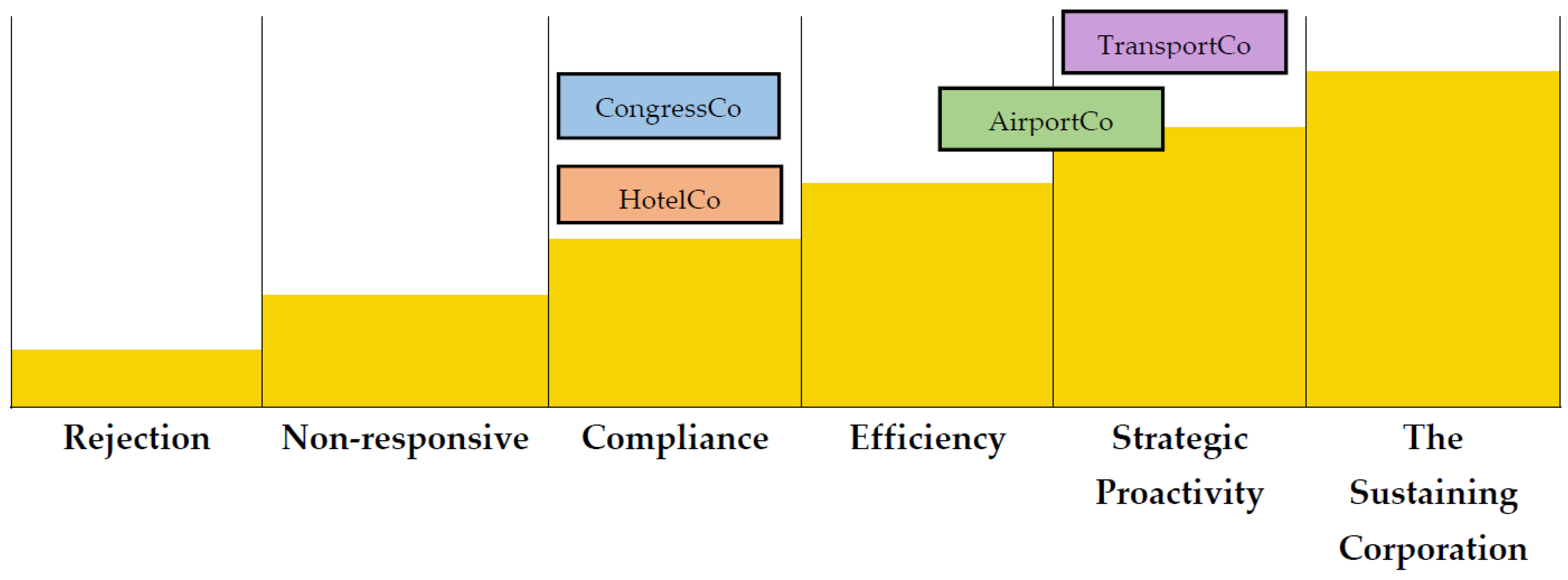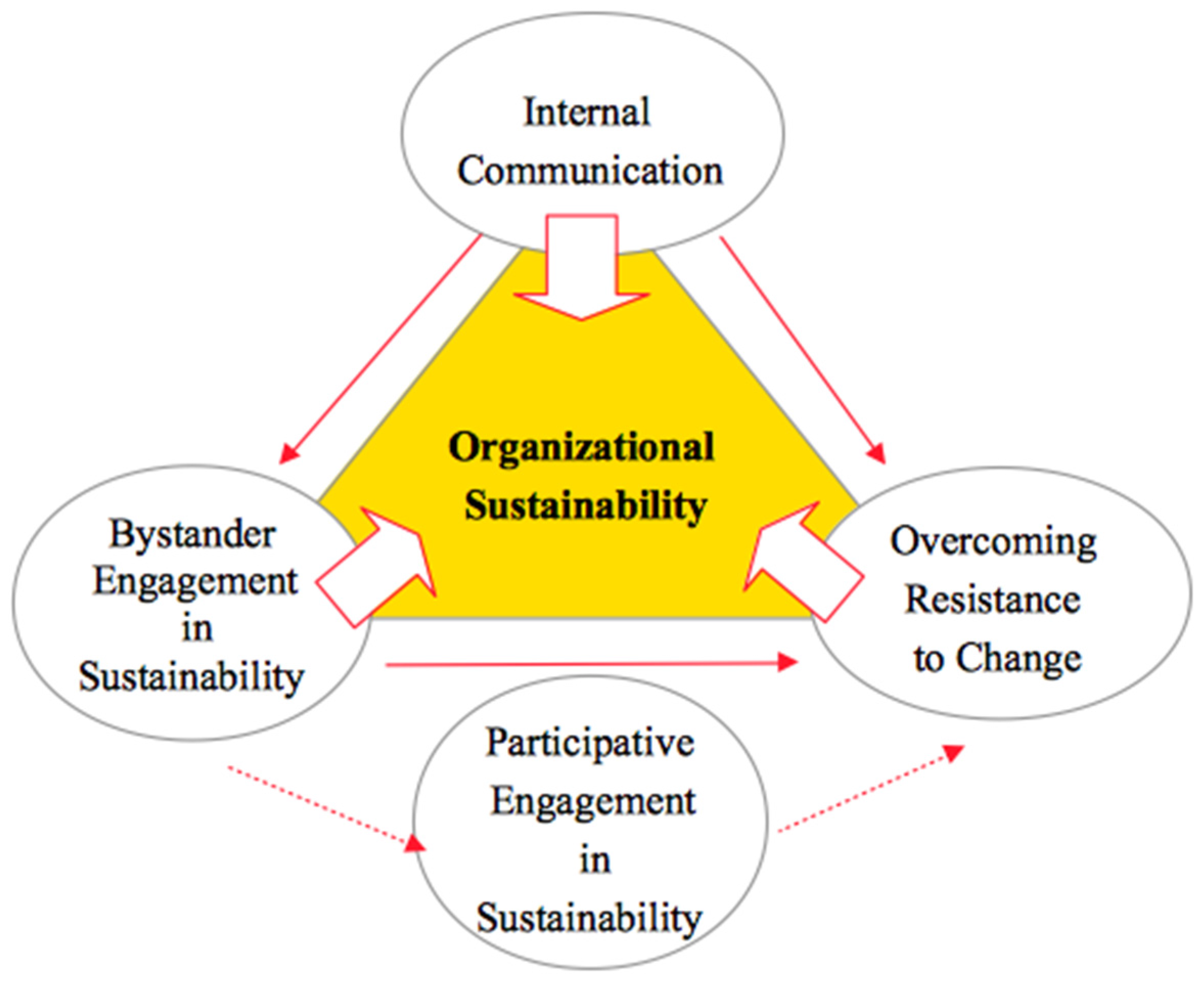Human Aspect as a Critical Factor for Organization Sustainability in the Tourism Industry
Abstract
:1. Introduction
2. Materials and Methods
2.1. Sampling
2.2. Data Collection and Analysis
2.3. Conceptual Framework
- (1)
- Resistance to Change: The seminal study by Coch and French [28] was the first to acknowledge resistance to change by employees and suggested that employees may react to change by being absent, displaying low efficiency, and showing aggression towards management. Similarly, as companies focus on installing change for sustainability they encounter resistance by employees at different levels. Based on Luthans' theory on attitudes, Lozano [29] explains attitudes and barriers to change at individual, group, and organizational levels. Accordingly, organizations develop diverse strategies to overcome barriers at different levels. In this research resistance to change questions were grouped into (1) resistance to change at individual, group and organizational levels, and (2) strategies used to overcome resistance at these levels.
- (2)
- Internal Communication: Effective internal communication can aid appropriate messages about sustainability implementation strategies to reach employees in a useful and acceptable manner. In this context, generally how sustainability is communicated to employees, or more specifically the content and the channels of communication, become critical for effective internal communication. Welch and Jackson [30] proposed to examine internal communication based on multiple stakeholders. The internal stakeholders are identified as line management, team peers, project peers, and corporate communication members. The fourth dimension is claimed to lead employee engagement and takes a broad approach, containing all employees rather than a specific group of employees. The framework that Welch and Jackson developed groups internal communication with regards to their level, direction, participants, and content. In this research internal communication questions were grouped into (1) participants, (2) direction, (3) content, (4) purpose, and (5) method.
- (3)
- Employee Engagement in Sustainability Practices: Human resource management (HRM) specialists can use CSR initiatives to attract, recruit, and retain employees that value an organization’s commitment to the society [31]. Similarly, HRM can direct people-related policies so that employees are encouraged to give support for and take part in sustainability initiatives. It is significant to achieve organization-wide commitment to sustainability in order to achieve higher sustainability performance. Savitz [31] argues that companies create two types of employee groups in terms of engagement in sustainability practices. The first group is defined as bystanders, who are not directly involved in sustainability practices but are informed and content with the sustainability practices of the company. The second group is participating employees who are actively involved in sustainability efforts of the company. Another distinction that Savitz [30] makes is whether organizations follow strategies to engage employees at their work life or also personal life. In this research, employee engagement strategies-related questions were grouped into (1) bystander engagement and (2) participative engagement.
3. Results
3.1. CongressCo
3.1.1. Sector and Company Background
3.1.2. Organizational Sustainability
3.1.3. Human Factors
3.2. AirportCo
3.2.1. Sector and Company Background
3.2.2. Organizational Sustainability
3.2.3. Human Factors
3.3. TransportCo
3.3.1. Sector and Company Background
3.3.2. Organizational Sustainability
3.3.3. Human Factors
3.4. HotelCo
3.4.1. Sector and Company Background
3.4.2. Organizational Sustainability
3.4.3. Human Factors
4. Discussion
5. Implications for Management and Conclusions
Acknowledgments
Author Contributions
Conflicts of Interest
Abbreviations
| NGO | non-governmental organization |
| MICE | meetings, events and conferences |
| CDP | Carbon Disclosure Project |
| HRM | human resource management |
| KPI | key performance indicator |
| CSR | corporate social responsibility |
| OH&S | Occupational Health and Safety |
| THY | Turkish Airlines |
References
- Millar, C.; Hind, P.; Magala, S. Sustainability and the need for change: Organisational change and transformational vision. J. Organ. Change Manag. 2012, 25, 489–500. [Google Scholar] [CrossRef]
- Elkington, J. Partnerships from cannibals with forks: The triple bottom line of 21st-century business. Environ. Qual. Manag. 1998, 8, 37–51. [Google Scholar]
- Linnenluecke, M.K.; Griffiths, A. Corporate sustainability and organizational culture. J. World Bus. 2010, 33, 7–41. [Google Scholar] [CrossRef]
- United Nations World Tourism Organization (UNWTO). Tourism Highlights. Available online: http://www.e-unwto.org/doi/pdf/10.18111/9789284416899 (accessed on 17 December 2015).
- Graci, S.; Dodds, R. Why go green? The business case for environmental commitment in the Canadian hotel industry. Anatolia 2008, 19, 251–270. [Google Scholar] [CrossRef]
- Galpin, T.; Lee Whittington, J. Sustainability leadership: From strategy to results. J. Bus. Strat. 2012, 33, 40–48. [Google Scholar] [CrossRef]
- Cooper, C.; Fletcher, J.; Gilbert, D.; Wanhill, S. Tourism principles and practice; Pitman Publishing: London, UK, 1993; p. 86. [Google Scholar]
- Liu, Z. Sustainable tourism development: A critique. J. Sustain. Tourism 2003, 11, 459–475. [Google Scholar] [CrossRef]
- Dewhurst, H.; Thomas, R. Encouraging sustainable business practices in a non-regulatory environment: A case study of small tourism companies in a UK national park. J. Sustain. Tourism 2003, 11, 383–403. [Google Scholar] [CrossRef]
- Stabler, M.J.; Goodall, B. Environmental awareness, action and performance in the Guernsey hospitality sector. Tourism Manag. 1997, 18, 19–33. [Google Scholar] [CrossRef]
- Benckendorff, P.; Moscardo, G.; Murphy, L. Environmental attitudes of Generation Y students: Foundations for sustainability education in tourism. J. Teach. Trav. Tourism 2012, 12, 44–69. [Google Scholar] [CrossRef]
- Bertels, S.; Papania, D.; Papania, L. Embedding Sustainability in Organisational Culture. Available online: http://www.nbs.net/wp-content/uploads/dec6_embedding_sustainability.pdf (accessed on 22 December 2014).
- Stoughton, A.M.; Ludema, J. The driving forces of sustainability. J. Organ. Change Manag. 2012, 25, 501–517. [Google Scholar]
- Dunphy, D.; Griffiths, A.; Benn, S. Organisational Change for Corporate Sustainability; Routledge: London, UK, 2003. [Google Scholar]
- VA Health Services Research and Development Service, Office of Research and Development. Organizational Change, Primer. Available online: http://www.hsrd.research.va.gov/publications/internal/organizational_change_primer.pdf (accessed on 20 February 2016).
- Battilana, J.; Leca, B.; Boxenbaum, E. How Actors Change Institutions: Towards a Theory of Institutional Entrepreneurship. Acad. Manag. Ann. 2009, 3, 65–107. [Google Scholar] [CrossRef]
- Verhulst, E.; Boks, C. The role of human factors in the adoption of sustainable design criteria in business: Evidence from Belgian and Dutch case studies. Int. J. Innovat. Sustain. Dev. 2012, 6, 146–163. [Google Scholar] [CrossRef]
- Denzin, N.K.; Lincoln, Y.S. Handbook of Qualitative Research; Sage Publications: Thousand Oaks, CA, USA, 1994. [Google Scholar]
- Yin, R.K. Case Study Research: Design and Methods; International Educational and Professional Publisher: Thousand Oaks, CA, USA, 1994. [Google Scholar]
- Bryman, A.; Bell, E. Business Research Methods; Oxford University Press: Oxford, UK, 2003. [Google Scholar]
- Stake, R.E. The Art of Case Study Research; Sage publications: Woburn, MA, USA, 1995. [Google Scholar]
- Eisenhart, K.M.; Graebner, M.E. Theory building from cases: Challenges and opportunities. J. Acad. Manag. 2007, 50, 25–32. [Google Scholar] [CrossRef]
- Yin, R.K. Case Study Research: Design and Methods; Sage publications: Woburn, MA, USA, 2003. [Google Scholar]
- Doppelt, B. Leading Change Toward Sustainability: A Change-Management Guide for Business, Government and Civil Society; Greenleaf Publishing: Sheffield, UK, 2003. [Google Scholar]
- Benn, S.; Dunphy, D.; Griffiths, A. Enabling change for corporate sustainability: An integrated perspective. Aus. J. Environ. Manag. 2006, 13, 156–165. [Google Scholar] [CrossRef]
- Mirvis, P. Employee engagement and CSR: Transactional, relational and developmental approaches. Calif. Manag. Rev. 2012, 54, 93–117. [Google Scholar]
- Verhulst, E.; Boks, C. Employee empowerment for sustainable design. J. Corp. Citizen. 2014, 2014, 73–101. [Google Scholar] [CrossRef]
- Coch, L.; French, J.R.P., Jr. Overcoming resistance to change. Hum. Relat. 1948, 1, 512–532. [Google Scholar] [CrossRef]
- Lozano, R. Are companies planning their organisational changes for corporate sustainability? An analysis of three case studies on resistance to change and their strategies to overcome it. Corp. Social Responsib. Environ. Manag. 2013, 20, 275–295. [Google Scholar] [CrossRef]
- Welch, M.; Jackson, P.R. Rethinking internal communication: A stakeholder approach. Corp. Comm. Int. J. 2007, 12, 177–198. [Google Scholar] [CrossRef]
- Savitz, A. Talent, Transformation, and the Triple Bottom Line: How Companies Can Leverage Human Resources to Achieve Sustainable Growth; John Wiley & Sons: New York, NY, USA, 2013. [Google Scholar]
- Karagöz, D. Event Tourism and Economic Impacts of Foreign Visitor’s Expenditures: The Case of Formula 1 2005 Turkey Grand Prix. Master’s Thesis, Anadolu University, Eskişehir, Turkey, 2006. [Google Scholar]
- Karagiannis, S. Statistical inferences in market research for sustainable development in conference tourism. ARPN J. Eng. Appl. Sci. 2009, 4, 32–38. [Google Scholar]
- Getz, D. Event tourism: Definition, evolution, and research. Tourism Manag. 2008, 29, 403–428. [Google Scholar] [CrossRef]
- Raj, R.; Musgrave, J. Event Management and Sustainability; CABI Publishing: Wallingford, UK, 2009. [Google Scholar]
- Paxson, M.C. Changing Trends in the American Meetings Industry. In Event Management and Sustainability; Raj, R., Musgrave, J., Eds.; CABI Publishing: Wallingford, UK, 2009. [Google Scholar]
- David, L. Environmental Impacts of Events. In Event Management and Sustainability; Raj, R., Musgrave, J., Eds.; CABI Publishing: Wallingford, UK, 2009. [Google Scholar]
- Turkish Airlines. Available online: http://www.turkishairlines.com/tr-tr/kurumsal/basin-odasi/basin-bultenleri/basin-bulteni-detayi/turk-hava-yollari-son-bes-yildir-avrupanin-en-iyi-havayolu (accessed on 14 January 2015). (In Turkish)
- Ergün, M. Havaalanı Sertifikalandırma Süreci ve Türkiye Uygulamasında Karşılaşılan Sorunlar ve Çözüm Önerileri. Master’s Thesis, Anadolu Üniversitesi Sivil Havacılık Yüksekokulu, Eskişehir, Turkey, 2006. [Google Scholar]
- Evcin, E. Türkiye Cumhuriyeti'nin ilk Yıllarında Turizm ve Tanıtma Faaliyetleri. Ankara Üniversitesi Türk İnkılap Tarihi Atatürk Yolu Dergisi 2014, 55, 23–82. (In Turkish) [Google Scholar]
- Kofteoğlu, F. Türkiyede Zincir Grup Oteller 2009; Ekin Grubu: Istanbul, Turkey, 2009; p. 10. (In Turkish) [Google Scholar]
- Assaf, A.G.; Josiassen, A.; Cvelbar, L.K. Does triple bottom line reporting improve hotel performance? Int. J. Hospit. Manag. 2012, 31, 596–600. [Google Scholar] [CrossRef]
- Kuster, J.; Huber, E.; Lippmann, R.; Schmid, A.; Schneider, E.; Witschi, U.; Wüst, R. Change Management and Dealing with Resistance. In Project Management Handbook; Springer: Berlin, Germany, 2015; pp. 267–281. [Google Scholar]
- Savitz, A.W.; Weber, K. The Triple Bottom Line; Jossey-Boss: San Francisco, CA, USA, 2006. [Google Scholar]
- Moran, B.; Paul, T. Employee Engagement: Advancing Organisational Sustainability. Available online: http://www.jsedimensions.org/wordpress/wp-content/uploads/2013/06/Brooke-Moran-and-Paul-Tame-finalproofMay2013.pdf (accessed on 25 February 2016).
- Hatipoglu, B. Sustainability management: A new career path? Proc. Int. Assoc. Bus. Soc. 2014, 25, 238–248. [Google Scholar] [CrossRef]
- Ehnert, I.; Harry, W.; Zink, K.J. Sustainability and HRM. In Sustainability and Human Resource Management; Springer: Berlin, Germany, 2014; pp. 3–32. [Google Scholar]
- Milliman, J. Leading-Edge Green Human Resource Practices: Vital Componenets to Advancing Environmental Sustainability. Environ. Qual. Manag. 2013, 23, 31–44. [Google Scholar] [CrossRef]
- Scott, C.; Bryson, A. Waking Up at Work: Sustainability as a Catalyst for Organizational Change. J. Corp. Citizen. 2012, 2012, 139–158. [Google Scholar] [CrossRef]




| Name of the Company * | AirportCo | TransportCo | HotelCo | CongressCo |
|---|---|---|---|---|
| Location | Istanbul | Istanbul | Istanbul/Ankara | Istanbul |
| Industry | Airport Management | Airport Transportation | Group (Including Hotels) | Meetings, Events and Conferences |
| Internationalization | Multinational | Multinational | Multinational | Multinational |
| Ownership | Publicly Listed | Publicly Listed | Privately Owned | Privately Owned |
| Employee size | 15,000 | 4000 | 31,000 | 70 |
| First self-standing sustainability report | 2010 | 2013 | 2014 | None, NGO membership |
© 2016 by the authors; licensee MDPI, Basel, Switzerland. This article is an open access article distributed under the terms and conditions of the Creative Commons by Attribution (CC-BY) license (http://creativecommons.org/licenses/by/4.0/).
Share and Cite
Ulus, M.; Hatipoglu, B. Human Aspect as a Critical Factor for Organization Sustainability in the Tourism Industry. Sustainability 2016, 8, 232. https://doi.org/10.3390/su8030232
Ulus M, Hatipoglu B. Human Aspect as a Critical Factor for Organization Sustainability in the Tourism Industry. Sustainability. 2016; 8(3):232. https://doi.org/10.3390/su8030232
Chicago/Turabian StyleUlus, Mehmet, and Burcin Hatipoglu. 2016. "Human Aspect as a Critical Factor for Organization Sustainability in the Tourism Industry" Sustainability 8, no. 3: 232. https://doi.org/10.3390/su8030232
APA StyleUlus, M., & Hatipoglu, B. (2016). Human Aspect as a Critical Factor for Organization Sustainability in the Tourism Industry. Sustainability, 8(3), 232. https://doi.org/10.3390/su8030232





